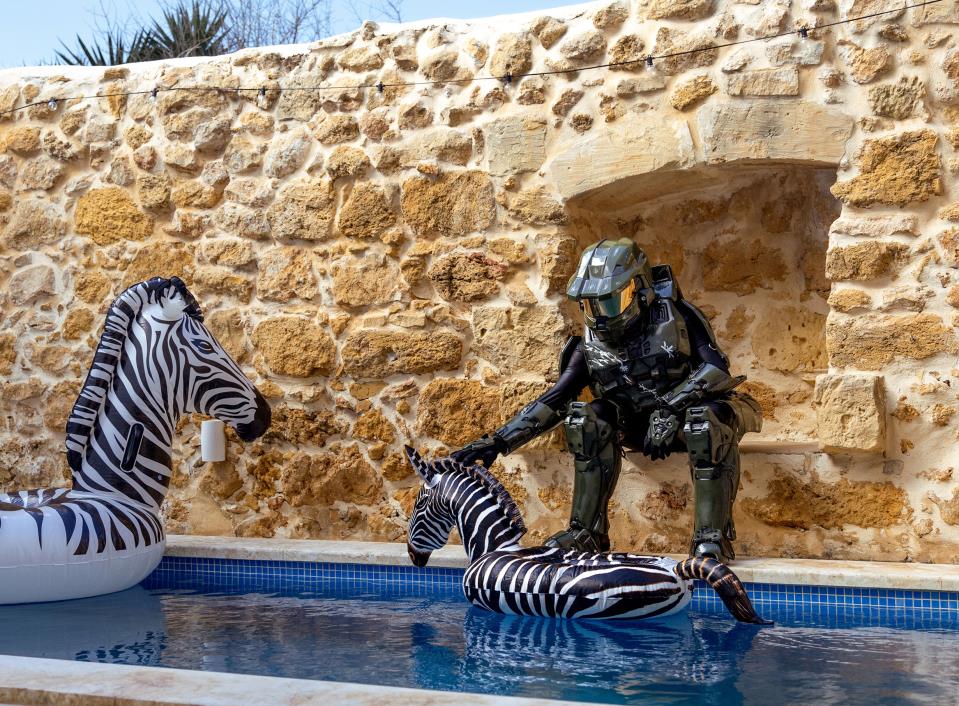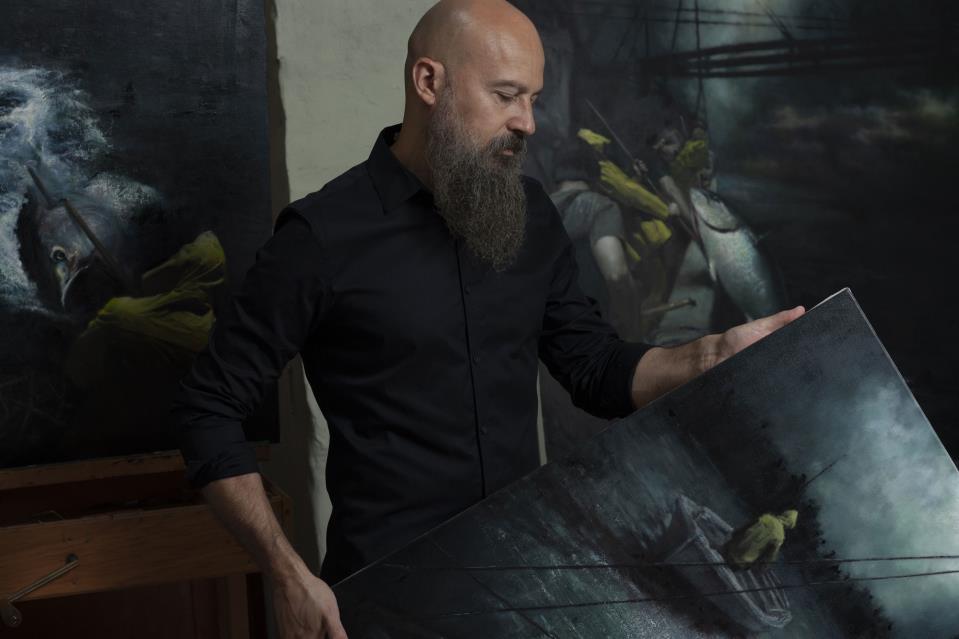Perhaps it will be the first of a series. The collective exhibition titled The Rabbit Hole Collective #1 is on at il-Kamra ta' Fuq until 11 May, curated by yours truly. Five artists came together with some strange ideas - and of course, I love and crave strange ideas... and here we are.
Partial truth be told, the exhibition came to be in a rather bizarre (1) way, following a series of unexpected events. So it only made sense to go with such a theme. I really like the word bizarre, so I'll try to use it at least five times in this article - don't blame the proofreader!
What does it mean to go down the rabbit hole, or to fall into one? The phrase has become a metaphor for being transported into a wonderfully (or disturbingly) surreal state - or into a bizarre (2), confusing, and often nonsensical situation.
No secret - I have a big soft spot for surrealism, and for those intriguing compositions and subjects that trigger that mind-blowing switch in the viewer (for lack of a better word). To cut the story short, the artists taking part in this exhibition are Maria Baldacchino, Karl Fröman, Maria Fröman, SJ Fuerst and Luca Indraccolo. Each explores surreal states in their own unique way - both stylistically through their chosen media, and conceptually through the themes they tackle.
A quick background check reveals some strong connections between these artists. In fact, four of them share an academic lineage: Karl Fröman, Fuerst, and Indraccolo all studied at the Florence Academy of Art and thus stem from a classical approach to painting. Baldacchino, in turn, is a student of Fröman, and one can perceive his influence in her work through subtle stylistic echoes and thematic direction. Maria Fröman, aside from demonstrating a classical approach in her, also happens to be Karl's mother.

Starting with SJ Fuerst - and my excitement to collaborate with her for the second time. I've visited her studio a couple of times, and it's always impressive to see the immense amount of work that goes into each of her paintings. To create her striking and unforgettable compositions, she sources all the props and costumes that appear in her works.
In her three small pieces in this exhibition, I feel she takes things a step further. The props - three inflatable animal pool toys (inflatables are a recurring element in her hyperrealist work) - become an integral part of the paintings themselves, transforming into wall-mounted alto rilievo sculptures. She paints beautiful female faces onto each inflatable, which are then set against classical-looking backgrounds inspired by Roman frescoes, early naturalist illustrations, and the dreamlike imagery of Odilon Redon. The result is a whimsical yet striking contrast.
The plastic animals are stuffed, evoking taxidermy specimens found in natural history museums. This gesture subtly comments on the overwhelming presence of plastic in our lives and the mass production of objects meant to mimic nature - in this case, a plastic inflatable animal imitating a taxidermied one.
Another artist I've collaborated with before is Karl Fröman. I curated his solo exhibition From chaos we are borne at il-Kamra ta' Fuq. Not much has changed - he still replies every four days or so, he's still always late, and I still struggle to get on his train of thought. I asked all the participating artists to give me a few notes about their works, and I admit, I'm still trying to decipher what Karl wrote. So, here's my take on a couple of his pieces.
Three of Karl's works in this show feature "LEGO sculptures". Polly wants a podcast presents a parrot built from the iconic bricks and then recaptured in 2D through painting. The piece might be hinting at the current podcast craze, many of which simply echo what audiences want to hear, all for popularity's sake, just like LEGO sets, which are massively popular among younger generations. You can build whatever you like, but in the end, nothing is truly real. This links neatly to Fuerst's work and her commentary on mimicking reality.
Another LEGO-based piece, The fast and the frivolous, features a shiny red sports car and a little LEGO man, well-dressed, spanner in hand, safety helmet on, standing proudly beside it. The scene is framed by an "Art Nouveau"-inspired border made of thick, interwoven paint strokes. It's unclear whether the figure has just finished building his dream car or if he's moments away from tearing it apart. The mischievous smirk on his face leans toward the latter.

Maria Fröman's still-life works recall Dalí's Nature morte vivante, as she presents a series of apples that appear to defy gravity. In Wisdom - a reference to the Tree of the Knowledge of Good and Evil - the artwork features 12 "portraits" of floating apples. There's a restrained Pop Art sensibility here, reminiscent of Warhol's Shot Marilyns. The temptation to reach for the forbidden fruit is heightened, as each apple seems ready to burst out of the canvas and land in the viewer's hand.
Another apple-themed work, Visual music, features more floating apples, this time contained within glass bottles, precariously balanced on vertical wooden beams. For the artist, this piece is a visual homage to Bob Marley's Three little birds, with its comforting refrain: "Every little thing is gonna be alright."
Her third piece in the show shifts direction entirely. Foil presents an almost hyper-realistic rendering of a crumpled piece of foil, transformed into a luminous, abstract composition. It's a reminder that not everything is as it seems. A discarded piece of shiny foil can hold unexpected beauty, while, conversely, not everything that glitters should be seen as treasure.

Luca Indraccolo presents seemingly surreal, bizarre (3) scenarios, inspired by his upbringing in Naples and his reflections on its current social realities. One such work, SMF•75•1•7•76, features a modern interpretation of Pulcinella, depicted as a man in a neat suit and white shirt, adorned with the iconic Pulcinella mask, complete with its exaggerated nose and furrowed brows. His head is covered by the traditional soft conical hat, its point draped over his shoulder, as he sits comfortably atop a pile of garbage - beautifully rendered, almost like a soft, puffy cloud. The work reflects one of Naples' most enduring and troubling images in recent years: that of overflowing trash bags on the streets. It becomes a surreal symbol of a city suspended between cultural grandeur and social decline.
Another striking work, SMF•72•21•6•90, shows a female figure engulfed in a swirling cloud of smoke. Though visually calm and sublime, the image recalls the devastating fires that swept through the National Park of Mount Vesuvius in the summer of 2017. Vast stretches of Mediterranean scrubland were consumed, releasing enormous quantities of ash into the atmosphere. For Luca, "this disaster crystallised into the image of a young woman engulfed by smoke - a surreal representation not only of the event itself, but also of its profound impact on the people of the region".

Baldacchino offers a series of figures set within abstract environments - enigmatic scenes that might narrate a hundred stories, or perhaps none at all. In Dispossessed and Yellow apparition, the artist raises questions about the loss of one's identity. Perhaps there is a need to be somewhere else, but physically, it's impossible. I would call it a "dislocated inner self" - where do we belong? Are we where we're supposed to be?
Both works prominently feature the colour yellow. The reason behind them is a very personal one: they reflect the time when Maria and Karl had to give up their beloved studio in Żabbar, where they kept an iconic yellow sofa that served as both muse and prop for many artworks.
Another work that presents a bizarre (4) scenario is 8th Circle. Inspired by Dante and The Master and Margarita by Mikhail Bulgakov, the piece depicts a dinner party steeped in alcohol, substance abuse, masks and horns. All the characters are hiding their real stories behind their masks. To me, it immediately evokes the 1962 surrealist black comedy El ángel exterminador by Luis Buñuel, which tells the story of a group of wealthy guests who find themselves unable to leave after a lavish dinner party, and the chaos that ensues.
This body of work invites viewers to delve into the possible narratives behind each bizarre (5) piece, sparking the imagination to explore the why and what of the stories they may hold.